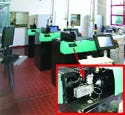A laser cutter is the cornerstone of what ultimately may be a fully automated system
January 20, 2007
Originally Published MPMN January/February 2007
PROFILE
Automating Stent Production, One Step at a Time
A laser cutter is the cornerstone of what ultimately may be a fully automated system
Klaus Vollrath
|
The control system is equipped with a touch screen monitor. |
Stent manufacturing currently is characterized by multiple manual operations and open-loop, batch-oriented quality assurance procedures. The development of advanced stent products, however, requires an even greater degree of repeatability and process control than has been the norm. Diode-pumped fiber laser cutting systems can play a key role in achieving increased speed, accuracy, and process control, according to Eduard Fassbind, CEO of Switzerland-based Swiss Tec AG. Operating facilities in Zürich and Schann, Fassbind designs and builds custom turnkey laser-based micromachining systems. The company recently developed equipment for a medical device OEM in Germany that led to a dramatic increase in productivity. The customer considers the laser cutter to be the cornerstone of a process that will go from tube to stent without any manual intervention.
“The emergence of new generations of stents created the need for an in-depth redesign of the entire manufacturing process chain,” says Michael Giese, CEO of eucatech AG in Rheinfelden, Germany. The firm fabricates devices for use in interventional cardiology and radiology; stent systems and related equipment are a specific focus. The advent of drug-eluting stents has led to new, more-stringent standards, notes Giese. For example, to ensure that the correct amount of drugs are embedded in a stent, US FDA prescribes a restricted scatter bandwidth for the total surface area of the stent. This significantly narrows allowable tolerances from the traditional 15% to a mere 6 to 8%. These requirements, accompanied by a trend toward a reduction in strut dimensions from about 110 µm to as little as 60 µm, made the company’s existing laser cutting systems obsolete. As Giese further considered the ramifications of evolving demands from the marketplace, it became clear to him that the entire process-chain layout would have to be reassessed. A semiindustrial approach involving scattered manual operations and batch-oriented quality assurance ultimately will be replaced by a monolithic, IT-based total quality management system, notes Giese. He has begun building the foundation of such a system.
|
A new tube-cutting, -drilling, and -welding system from Swiss Tec enabled a stent manufacturer to dramatically increase productivity and reduce rejects. |
A Cut Above
“Laser cutting is the start of the process chain,” says Fassbind, “but it is crucial that it be done right to achieve the desired final result.” For the eucatech project, the firm used a tube-cutting, -drilling, and -welding system equipped with a 50-W diode-pumped fiber laser source from SPI Lasers Ltd. (Southhampton, UK). Carefully tailored to meet the requirements of maintenance-free always-on industrial-scale production, the Swiss Tec micro-T15 comprises a sturdy granite base, linear-drive x-axis, proven laser forming and focusing system, and state-of-the-art control system. The latter includes a CCD camera to monitor the focus of the laser beam on the workpiece. Spot sizes in the 10- to 12-µm range and cutting speeds of 500 to 600 mm/min are routinely achieved. By contrast, the previous tool only achieved cutting speeds of 150 to 200 mm/min. Fassbind has run tests on systems attaining cutting speeds of 800 mm/min with promising results; ultimately, he anticipates achieving speeds beyond 1000 mm/min.
Diodes Pump Up Laser Performance
“One of the features we like best about the new plant is the diode pump technology,” says Giese. The company’s previous equipment used lamps, which have a relatively short, approximately 2000-hour, life span. They also can cause drift, which affects the laser beam’s performance and can result in inconsistent results. All too often, substandard or out-of-tolerance parts would be produced after only a few hundred hours of lamp life, says Giese. “We would have to stop production while the laser system was thoroughly readjusted. The task could take more time than a full shift, and it required the involvement of highly qualified—and highly paid—specialists,” explains Giese.
Diode-pumped lasers, on the other hand, can be serviced by nonspecialized personnel and remain stable over a long period of time. Since the new system was installed, downtime has been cut in half, machine usability has soared to more than 90%, and the percentage of rejected parts has diminished, according to Giese. Moreover, throughput has doubled compared with the old system.
“The laser cutting system is just the first building block in what will be a complete automated production chain,” explains Giese. Thus far, he has installed an inspection system and a heat-treatment station. Eventually, additional plants and robotic and conveyor systems will be integrated into the process chain.
Because of the scale of this project, Giese required more from his equipment supplier than simply machine-building capabilities. He needed someone who “would be willing to team up in an ongoing innovation process. This aspect played a key role in our selection of Swiss Tec,” says Giese.
Swiss Tec will be exhibiting at MD&M West 2007 in Anaheim, CA.
Copyright ©2007 Medical Product Manufacturing News
You May Also Like




